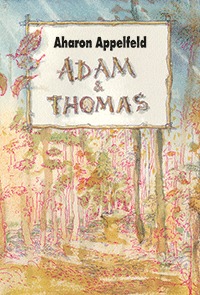I am so happy to celebrate Adam and Thomas (Triangle Square Books), this year’s winner of the Sydney Taylor Book Award for older readers. Originally published in French, author Aharon Appelfeld tells the story of two nine-year-old boys whose parents have sent them to the forest during World War II. The boys rely on one another for safety, companionship, and survival. Vibrant illustrations accompany the engaging text, making Adam and Thomas a stand-out middle grade novel.
As a child, Aharon Applefeld escaped a concentration camp during the war and lived in the forest for three years. Today, he lives in Israel. Aharon once said, “The holocaust is a central event in many people’s lives, but it also has become a metaphor for our century. There cannot be an end to speaking and writing about it. Besides, in Israel, everyone carries a biography deep inside him.”
Jeffrey Green, the translator of Adam and Thomas shared his thoughts with me about this lovely book.
Aharon, Adam and Thomas is such a compelling story – two boys braving the wilderness in unspeakable circumstances. The boys also seem to create a spiritual relationship with animals. How significant is this relationship to the boys’ survival?
I believe that what gives this story universal appeal for children is that it is about the discovery of inner resources, especially those of the bookish Thomas. Thomas learns how to communicate with dogs from Adam, and from the dog, Miro, and this opens him up to the deeper strengths of his personality. Adam also learns a great deal about what he can do and cope with, mainly about the value of being helpful and supportive, a good friend. Both boys are called upon to deal with situations that no child in ordinary life can be expected to deal with, and his ability to communicate with Miro and the other dog, who enters and leaves their life, is also a sign of the resources they discover in themselves.
It’s important to note that for children who hid in the forest, like Aharon himself, during the war, dogs were in fact very threatening. The peasants kept watchdogs to keep away intruders, and the children had to find food and shelter with the peasants on the edge of the forest, the way Adam milks the cow in the meadow. So the presence of the good dog in the book is not strictly realistic – or at least it glosses over the dangers also represented by dogs.
It is difficult to impart to today’s children the horrors of this time in history. Adam and Thomas are in a scary situation but their story is hopeful and full of heart. Was it difficult to find this balance while writing the story?
I can’t answer this for Aharon, but in personal conversation he has told me more than once that the experience of hiding in the forest was not entirely negative. There were moments of great beauty and even of religious insight. Obviously, in writing for young readers, he didn’t want to present the full nightmarish side of the dangers he faced, or of the outlaws who sheltered him from time to time: thieves and prostitutes. He made the story into a kind of boys’ adventure story, with which young readers could identity, and this was a brilliant literary move. I think that no adult, reading this, with more extensive knowledge of the Holocaust, can see it through the eyes of a child. I also think that a child who has read this book, when he or she is old enough to process fuller information on the Holocaust, will find it easier to identity with the victims because of this book.

What do you want young readers to come away with after reading Adam and Thomas?
Again, I can’t speak for Aharon. I have grandchildren of the age appropriate for this book, and I hope that they will learn about the Holocaust from it, but also learn about finding inner resources to cope with difficult situations, not the extreme situations of the book, of course, but still, young people are called upon to cope with problems, new situations, dangers, and the example of Adam and Thomas could strengthen them.
Adam and Thomas is a unique story in many ways. The full color illustrations add so much to the text, but this is an unusual format for a novel. How did the decision to add illustrations come about?
I believe that the illustrations were originally for the French edition, so you’d have to ask the French publisher. When I first saw the book I was extremely pleased by the design and the illustrations. They add a great deal to the attractiveness and accessibility of the story. I would like to add that writing for younger readers was a departure for Aharon, and a daring one, because his books for adults are extremely sophisticated literarily (though they appear to be simple) and full of irony that is not appropriate at all for a young audience. I’m not sure why he decided to write the book, but it brings out a warm side of his personality, because he had to avoid some of the harshness of his subject.
Thank you, Jeffrey, for your thoughtful responses.
Readers, many thanks for stopping by on the Sydney Taylor Book Award Blog Tour! Be sure to check the schedule (link below) for other stops on the tour.
Please check out links for Association of Jewish Libraries, Sydney Taylor Book Award, AJL Blog Tour Schedule

This book was originally published in Hebrew and not in French. Jeffrey Greene translated the book from the original Hebrew. The cover picture is very different than the original Hebrew edition. I assume the English publisher preferred the French pictures. The cover picture of the Hebrew edition was quite dark.
I just happened to find your blog – great to have a blog about Jewish children’s books.
Thank you for this interesting information!